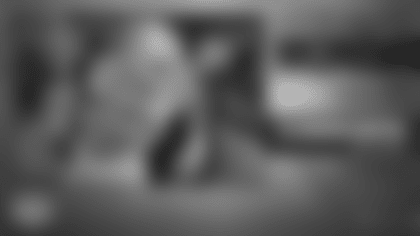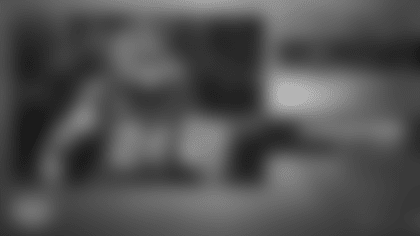Here's five takeaways from Redskins Director of College Scouting Scott Campbell's media session with reporters before the NFL Draft on April 24, 2017, in Loudoun County, Va.
1. The Redskins' draft philosophy is taking the best player available.
Each year the question is asked, and each year the answer remains the same. Barring extreme circumstances, the Redskins will approach the NFL Draft by taking the best player available when it comes time to select a player.
Washington has needs at certain positions, but if a player at the top of the team's board is still available when the time comes, regardless of plugging a hole, that player will be drafted.
"And if that serves your needs, that's a bonus," Campbell said. "Certainly ideally you have enough different players, there is not one sitting there like a left tackle. If a left tackle is sitting there, that is really not a big need for us – maybe you guys have a different opinion. Then you are going to go in a different direction than that and hopefully you have guys graded in that pocket where you're not really reaching for position. You are taking another position that you may need better."
2. Game tape is the most important factor in evaluating a player.
Considering he's been scouting players for 30 years, Campbell considers himself an old school guy, which means that he still relies on a prospect's game tape when evaluating their talent. This isn't to say that the NFL Combine is unnecessary.
His time in Indianapolis is to get a better sense of measurables and to add context to the players they've been closely staring at on screen for the last couple months using in person interviews. A great 40-time won't decide a draft selection, but it will help in etching the final details about a player's value.
"The tape is always the fallback," Campbell said. "The combine helps you get to know the players as a person, it gives you good information on the physical part of it, the doctors, and you fill in some numbers. We don't know exactly how tall they are, how much they weigh, how fast they are, so that gets factored into it. Of course, all those things are important to play pro football. But at the end of the day, it comes down to watching the tape and seeing what kind of player they are on tape. That's the most important thing."
Campbell doesn't focus on specific drills to make a decision, but takes a more holistic view of their performance in Indianapolis – including their interview.
"What I do, when they go through their drills, I put a plus or a minus, plus-minus, all the different drills they do, and so if you add up your plusses and minuses, you kind of have a feel and an impression, and I'll do like an A/B/C grade as they do the drills," he said. "In terms of the combine itself, it's the 15 minute interviews we get to do. Just the first impressions is my favorite part of the whole process."
3. Evaluating quarterbacks has continued to be a focus for the integrity of the board.
While the Redskins already have their starting quarterback for this season, and potentially for years to come pending a long-term contract is signed before July 15, and while they already have a capable backup in Colt McCoy and another young quarterback in Nate Sudfeld on the roster, the Redskins will not ignore evaluating this year's quarterback class.
"We are approaching it like we do with all the other positions. For the integrity of the board, you have to grade all the position," Campbell said. "I mentioned the left tackle, we can't just say, 'We got Trent Williams, we can't evaluate the left tackles.' You have got to evaluate all the quarterbacks, all the other positions just like all the others, for the integrity of the board to kind of keep the balance and understand what's going on there and decide what direction you're going to go once you do that. So in my mind, when you enter it, all positions are open, everything is open and then you decide as you move along and the board starts to flow."
For Campbell, as college offenses have become much simpler, more work is put into quarterbacks than just viewing game tape.
"You can't really just watch a guy play, so what does that leave you with?" Campbell said. "It leaves you with just studying their physical attributes. Are they athletic? Can they move in the pocket? How quick is their release? Can they read the defense? And some of those systems limit what they're going to be asked to do. Some of those, that Air Raid offense, they're not asked to make multiple reads and all that kind of stuff. They're working off of one side of the field. You have got to start digging more on the guy as a person, how much he likes football, is he going to put the time in to study it? Because, ultimately, that's what he's going to have to do. He's going to have to learn a whole new system. It makes it much tougher to project a guy's success."
4. Campbell explained how responsibilities are divvied out in the draft room.
By now, most of the arguments have been settled and the team carries a united front with it on draft day. As Campbell said, "it's all been worked out, hashed out," between the scouts and coaching staff regarding which players will and should be taken.
Just who will be involved in this whole process?
"Bruce [Allen] will be involved, definitely, and Jay [Gruden], of course," Campbell said. "Everyone will be involved in the final Redskin grade at the end of the day. And the goal is to not have panic on draft day. You want to have all that stuff… You don't want to have a brand new argument break out right there before you're picking. That's ridiculous. I've never seen that happen in any team I've been with."
If any trades get offered or a trade becomes available, that will mostly be the responsibility of Eric Schaffer and Alex Santos, who will be assigned a handful of teams to call and speak with during the draft.
"Once they get that information, they'll tell the table in the front and say, 'Hey, we can trade back for this, we can trade up for that.' It would be me and Bruce and Jay saying 'No, no, we've got enough guys there' or say 'I like these guys,' or like, "Hey, there's guys there.' So it's kind of a discussion amongst the people, and most times it's Bruce saying, 'Just tell them we're not interested,' or he says, 'Get the league on the phone. We're going to make that trade.'"
5. Saturday, the final day of the draft, can get pretty crazy.
Once the first three rounds finish on Friday night, the final four rounds take place on Saturday afternoon. That means a lot more options are on the table in terms of trades and re-assessing the draft board.
"Most of the work is done pre-draft," Campbell said. "So it's all ranked top to worst, so you're excited that guys are there. I think you see a lot of trades to move up at the beginning of the day because everyone's reassessed, like, 'We've got this guy, he was our third-rated corner, or we had a guy in the second round that's still there, so let's trade up and get him before waiting whenever our pick is.' There's a little bit of that going on, but mostly, the work's already done. You just kind of reassess who you may have a chance at."
When the draft is officially complete, the next phase includes scooping up the many players who went undrafted. Eric Schaffer starts calling agents of the players still on the Redskins' board, determining the amount of money he can allocate to each of them, and then the Redskins go after the highest-rated players available.
"I assign a scout to all the coaches, and really the coaches talk to the players – once the draft ends, let me be clear, it's after the draft ends when we start making calls – the scouts are on the phone with the agent finding out what our competition is, how much," Campbell said. "But everyone that's left up there, that's who we're frantically chasing and trying to sell opportunity. At that time, you're talking five-, 10-thousand, you're not talking millions of dollars. You're selling opportunity to come in, win a job and get a contract, ultimately, for those guys."









